Enoshima
last update: August 16, 2021
Enoshima (江の島) is a small island located just 200 meters from the coast, but connected to the mainland by two bridges, one for cars and another for pedestrians. Enoshima is often visited by tourists along with the famous
Kamakura a few kilometers away, making a day trip from Tokyo. The island is over half of its extension covered with vegetation, and houses a Shinto shrine, a garden with an observation tower, a spa, as well as some caves. The coast in front of Enoshima is characterized by long beaches covered with black volcanic sand and is typically known as the
Shōnan region. From both Enoshima and the surrounding beaches you can enjoy a wonderful
view of Mount Fuji.
Things to do and things to see in Enoshima
On the island
Once you have crossed the bridge and reached Enoshima, you will arrive in the small town of the island, where about 300 people live and which is teeming with restaurants, souvenir shops and even some small hotels. From here, walking to your left you will arrive in the eastern part of Enoshima, also accessible by car and occupied by a marina. Continuing to walk straight ahead you will venture into the wooded and slightly mountainous part of Enoshima, where the Shinto shrines, the Samuel Cooking Garden and other minor attractions are located. Finally, continuing to walk past the Samuel Cooking Garden you reach the southwestern coast of the island, a very interesting area from a landscape point of view, with a rocky coast and numerous caves.
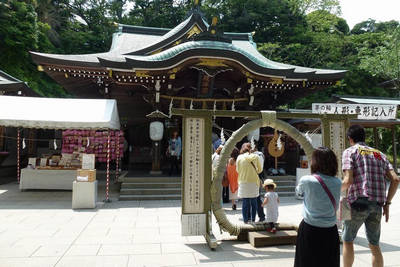
Enoshima Jinja
Enoshima Shinto Shrine is made up of three distinct buildings scattered throughout the island's forest. The most famous of the three, as well as the closest to the town, is the Hetsu No Miya shrine, characterized by an octagonal building that houses two precious statues of Benten (admission 200¥). One of these statues has an inestimable historical value, as it is one of the few in the world in which the divinity is depicted half-naked. A pond inside the shrine is sometimes used by some visitors to symbolically wash their coins. This happes because the figure of Benten is linked to wealth in the Shinto tradition, and this rite of washing money, propitiatory of fortunes, has spread in many of these shrines. The other two buildings belonging to the sanctuary are respectively two and ten minutes walk from the first, along well-marked paths. The first is called Nakatsu No Miya, the second is called Okutsu No Miya.
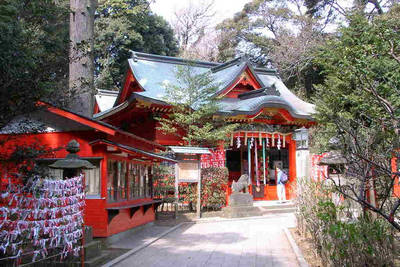
 Nakatsu no miya jinja and Okutsu no miya jinya
Nakatsu no miya jinja and Okutsu no miya jinya
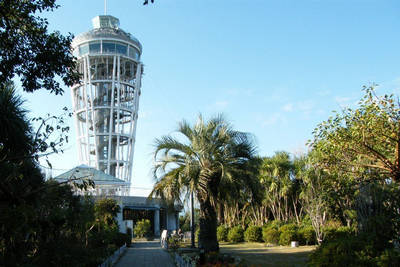
Samuel Cocking Garden
(admission 200¥, opening hours 9-20, map)
A botanical garden that owes its name to a certain Samuel Cocking, an English merchant who in 1880 bought a large part of the island, building on it his villa and a botanical garden where he collected tropical plants. Today there is still a botanical garden (reconstructed) and also a recently built lighthouse tower (Enoshima Sea Candle, admission 300¥) with an observatory on the top. The tower is 59 meters high but the panoramic observatory is located 120 meters above sea level. If the weather permits, the view of Mount Fuji is simply extraordinary.
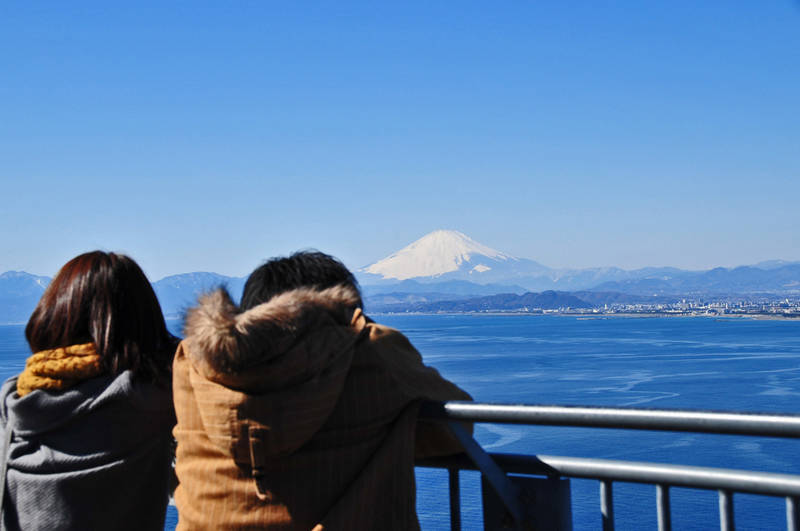 spectacular views from the Enoshima Sea Candle, the lighthouse inside the Samuel Cocking Garden
spectacular views from the Enoshima Sea Candle, the lighthouse inside the Samuel Cocking Garden
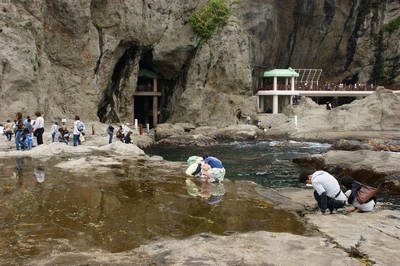
Iwaya Caves and South Coast
(admission 500¥, opening hours 9-18, 9-16 oct-feb)
On the south coast of the island, rocky and indented, there are two caves open to the public. To reach them you will first have to go down a staircase of 220 steps to the viewpoint called Chigogafuchi Abyss. Here the steep cliffs of the island flatten out to the sea, taking the form of flat stone slabs where people come to fish or sunbathe. By following the signs you can then easily find the entrance to the caves. The first cave, 45 meters deep and which at a certain point forks inside, houses various statues of a religious nature, and at a certain point along the way you can borrow candles to shed light in the darkest meanders. To reach the second cave you have to follow a pedestrian path with a breathtaking view of the sea. Inside this second cave is the statue of a ferocious green dragon, which according to an ancient legend once lived inside the cave. To return to the mainland from this point you will have to go up the steps and go all the way back. Or, on weekends and some holidays, near Chigogafuchi Abyss there is a small pier where boats take you to the bridge by sea for 400¥.
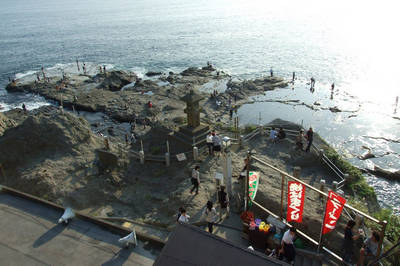
 the south coast of the island of Enoshima, near the caves
the south coast of the island of Enoshima, near the caves
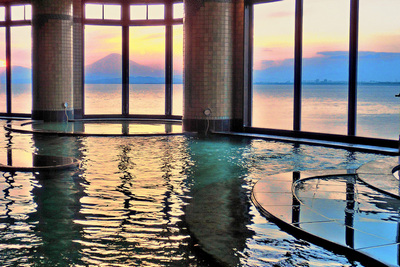
Enoshima Hotel and SPA (ex Enospa)
(ingresso 3175¥, 2000¥ dopo le 18, orario di apertura 10-22)
Enospa is a large wellness center and spa (onsen) located in the inhabited center of the island. Immediately after crossing the bridge, it can be seen on the right. Inside there are traditional Japanese thermal pools (therefore divided by gender and where to take a bath naked), but also normal western-style pools where you can bathe all together and wearing your costume, sauna, massage service and restaurant. The magnificent sea view from some pools and from the indoor restaurant are one of the strong points of this place. It has recently been expanded to include a hotel as well and is sometimes also called the Enoshima Hotel.
Facing the island
Beaches
Like the nearby Kamakura, this area is also very popular for summer beach tourism. The island of Enoshima has no beaches, but there are many along the opposite coast. Here you will find Koshigoe Beach to the east (and then Shichirigahama beach up to Kamakura), and the whole sandy coast of Sagami Bay which continues for several kilometers to the west. This area is also known as Shōnan region.
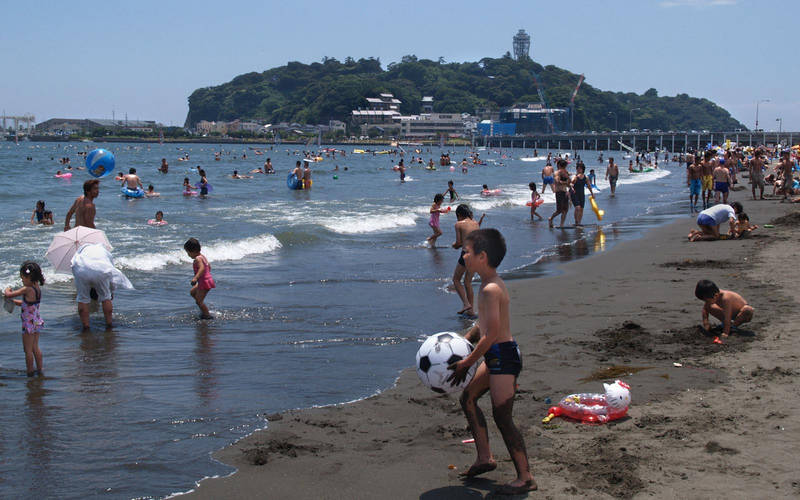 view of Enoshima Island from Koshigoe Beach
view of Enoshima Island from Koshigoe Beach
 night view of Enoshima island from the coast
night view of Enoshima island from the coast

Enoshima Aquarium
(admission 2500¥, opening hours 9-17, 10-17 dec-feb)
This aquarium is located just opposite Enoshima Island on the west side. It is one of the largest aquariums in the Kanto region and is home to around 20,000 creatures, most notably a collection of jellyfish with some truly spectacular specimens, and the chance to touch the backs of small shark specimens. Inside there is also an arena where you can watch dolphin and seal shows, with the island of Enoshima in the background. Summer weekends are the busiest days that are recommended to be avoided.
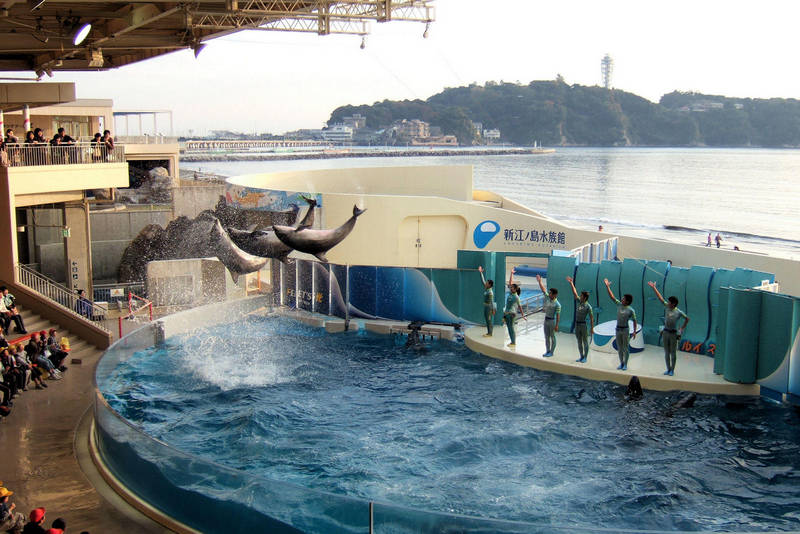 dolphin show with Enoshima in the background
dolphin show with Enoshima in the background
Where to stay in a Enoshima
On the island of Enoshima you will find several small family-run hotels to suit all budgets. One of the cheapest and most recommended is the
Kichinya Yagoro hostel (3500¥ per night). or a more exclusive experience, the
Iwamotoro ryokan (20,000¥ per night) offers traditional Japanese-style rooms directly overlooking the sea, with the option of traditional breakfast and dinner.
On the mainland, opposite the island in the city of Fujisawa, there are several other hotels. We especially recommend the
IZA Enoshima Guest House and Bar and the
Hotel Saika.
Eating in Enoshima, cafes and restaurants
Enoshima and its surroundings are famous throughout the region as a place to go and eat fresh fish and seafood, perhaps in a restaurant right by the sea. Two dishes in particular are very popular in Enoshima, the
shirasu don and
sazae. To try these dishes and many other Japanese seafood specialties with tables overlooking the sea, we recommend the
Enoshima Uomi-tei, a restaurant in the southwestern part of the island.
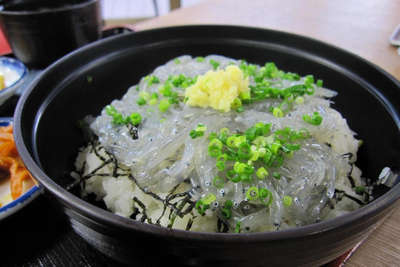
Shirasu don
The
Shirasu-don is nothing more than a bowl of steamed rice (donburi) with some
shirasu on top, a Japanese term for newborn small fish. Shirasu can be served on rice both raw (like sashimi) and cooked. The dish is often enriched with other ingredients, such as spring onions, ginger, egg, seaweed or other seafood.

Sazae
Sazae is a Japanese term that indicates a type of sea snail translated in English as "turban shell". They can be eaten in various ways, for example as a donburi garnish (
Sazae-don) or even simply cooked on the grill (
tsuboyaki).
How to get to Enoshima
There are three different stations around the island which include the name
Enoshima. The closest to the bridge is
Katase-Enoshima station (
Odakyū Enoshima Line), useful if you come directly from Tokyo and in particular from Shinjuku. About 800 from the bridge there is also
Enoshima station (
Enoden Line), which provides a direct connection to the nearby city of Kamakura. Finally, a few meters from the latter there is
Shōnan-Enoshima station (
Shōnan Monorail Enoshima Line), a monorail station that provides a connection with Ofuna, an important interchange station.
From Kamakura
The
Enoshima Electric Railway (Enoden) is a small coastal railway that connects
Kamakura station with
Fujisawa station, also stopping at
Enoshima station. It takes 25 minutes and the whole trip costs 260¥. On summer weekends, this line can be very crowded and you may have to wait in line for a long time before you can get on the train (the wagons are very small).
From Tokyo
To reach Enoshima directly from Tokyo, the easiest way is from
Shinjuku station, where you can take the
Odakyu Odawara line to
Sagami-Ōno station. From there you have to take the
Odakyu Enoshima line to the terminus
Katase-Enoshima station. It takes 70-80 minutes in total and the whole trip costs 640¥ ;. The trains of the two lines are almost always the same, so once you arrive in Sagami-Ōno there is no need to change, the same train will continue towards Enoshima.
The Odakyu company also offers the
Enoshima Kamakura Free Pass (1520¥), a day pass that includes a return ticket between Shinjuku and Fujisawa and unlimited use of the Enoden Line trains between Fujisawa and Kamakura and Odakyu trains between Fujisawa and Enoshima. If you want to visit both Enoshima and Kamakura it is a great way to save something, to visit Enoshima alone it is not worth it.
From Ofuna
From
Ofuna station you can take the
Shonan Monorail, a monorail suspended in the air, which reaches
Shonan-Ehoshima station in 14 minutes and at a cost of 320¥. If you come from Yokohama or other areas of Tokyo far from Shinjuku, going first to Ofuna and then changing to this line could be the fastest solution to go to Enoshima. The last stretch on the suspended monorail is also very fascinating, especially sitting in the first carriage at the head.
Map of Enoshima, Kanagawa
Guided tours, activities and other things to do
If you are planning a trip to Japan and you want to do something more than just visiting famous places and monuments, we suggest you to use
Rakuten Travel Experiences.
How to use Rakuten Travel Experiences
Rakuten Travel is a very useful website to
enrich your travel experience, especially if you are going solo or it's your first time in Japan.
Because of the language barrier (and more), in Japan it is very difficult to interact with the locals and to get off the tourist track.
Thanks to Rakuten Travel you can find a lot of interesting and sometimes unique
guided tours and activities all over Japan (and not only in Japan), that you would otherwise never be able to enjoy.
But there's more: on Rakuten Travel you can also
buy tickets for several famous attractions, events, transportation and other useful services for tourists. Last but not least, you can
reserve a table in hundreds of restaurants.
Some examples
Take a look at Rakuten Travel Experiences
You may also be interested in






